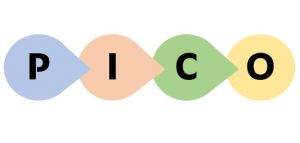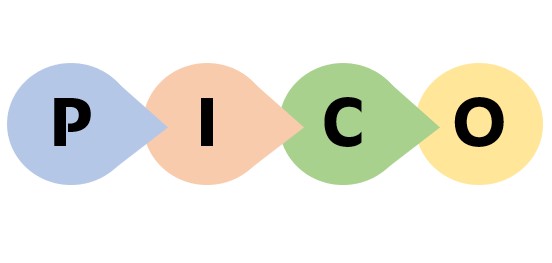Use PICO to Develop a Clinical Research Question for Your Thesis
For medical students, the process of research study is more challenging than the rest. Not only do they have to follow the same extensive process that every investigative examination requires but they also have to make sure that their research study does not become obsolete by the time it is completed as innovative developments in the medical field are quite frequent.

Since the most important step in any research is the development of the research question, let’s see how you can formulate it for medical research.
The best and most effective way to develop a clinical research question is through a Pico research question.
Pico is the most effective strategy for developing research questions for EBM (evidence-based medicine). This process tries to preview the effectiveness of a certain medical theory or practice, compares it with other alternatives, and then tries to assume the outcome that should be expected. Through the step-by-step process of PICO, you can develop a medical research question easily and effectively.
What does PICO mean?
P is for Patient Population:
Here you mainly try to gather data regarding the sample population that you will study. You will try to gather basic information about the patient. You can do so by answering the following questions:
-
- How would you describe the patient?
- What are the main characteristics of the patient?
- The main problem that he is facing.
- What is the gender, age, and location of the patient?
- What is the health or disease status of the patient?
- Would you describe patients in similar conditions in the same way?
For Example:
A 50-year-old woman with arthritis
I for Intervention:
Here, you will answer what you plan to do with the patient’s disease?
-
- What type of medicines, treatments, or exposures are you considering for the patient?
- What will you prescribe to the patient? Some drug?
- What was the patient exposed to?
For Example:
The 50-year-old arthritis patient will be subjected to a drug named COX-2 Inhibitor.
C is for Comparative Alternatives:
Here, you will try to describe what are the main alternatives available to test the intervention?
-
- What different types of treatments are available?
- Is there a choice between two drugs for the disease?
For Example:
The alternatives for the disease were physiological massages.
O is for Outcome:
Here, you will try to answer, what do you wish to achieve, expect, measure or improve through the alternative that you have selected?
-
- What is the expected result of the drug or operation that the patient was subjected to?
- What are the relevant outcomes through this?
For Example:
Reduction in pain and inflammation
List of PICO Research Question Examples
PICO is a framework used to develop research questions in evidence-based practice, especially in healthcare and clinical research. It stands for:
- P (Population/Problem): Who is the patient or what is the problem?
- I (Intervention): What is the intervention or treatment being considered?
- C (Comparison): Is there an alternative or control group?
- O (Outcome): What are the expected outcomes?
Here are 20 examples of PICO research questions:
- P: Adults with type 2 diabetes
I: Exercise intervention
C: No exercise
O: Improvement in blood sugar levels - P: Children with asthma
I: Use of inhaled corticosteroids
C: Use of oral corticosteroids
O: Reduction in asthma exacerbations - P: Elderly patients with hypertension
I: Low-sodium diet
C: Normal diet
O: Blood pressure control - P: Pregnant women
I: Folic acid supplements
C: No folic acid supplements
O: Prevention of neural tube defects - P: Smokers
I: Nicotine replacement therapy
C: Behavioral therapy
O: Smoking cessation rates - P: Patients with depression
I: Cognitive-behavioral therapy (CBT)
C: Medication
O: Improvement in depressive symptoms - P: Postmenopausal women
I: Hormone replacement therapy
C: No hormone replacement
O: Risk of cardiovascular disease - P: Adults with obesity
I: Bariatric surgery
C: Lifestyle changes (diet and exercise)
O: Long-term weight loss - P: Patients with chronic low back pain
I: Physical therapy
C: Surgery
O: Pain relief and functional improvement - P: Patients with high cholesterol
I: Statin therapy
C: Diet modification
O: Reduction in LDL cholesterol - P: Children with ADHD
I: Behavioral interventions
C: Pharmacological treatment
O: Improvement in attention and behavior - P: Patients with Alzheimer’s disease
I: Use of donepezil
C: Placebo
O: Delay in cognitive decline - P: Patients undergoing knee replacement surgery
I: Post-operative physical therapy
C: No physical therapy
O: Time to functional recovery - P: Patients with acute ischemic stroke
I: Administration of tPA (tissue plasminogen activator)
C: No tPA
O: Improved neurological outcomes - P: Infants with jaundice
I: Phototherapy
C: No phototherapy
O: Reduction in bilirubin levels - P: Adults with sleep apnea
I: Continuous positive airway pressure (CPAP) therapy
C: No treatment
O: Reduction in apneic episodes - P: Patients with COVID-19
I: Use of antiviral drugs
C: Standard care
O: Reduction in severity and duration of symptoms - P: Patients with osteoporosis
I: Bisphosphonates
C: Calcium and vitamin D supplements
O: Reduction in fracture risk - P: Patients with acute myocardial infarction
I: Early administration of aspirin
C: Delayed aspirin administration
O: Reduction in mortality - P: Adults with anxiety disorders
I: Mindfulness-based stress reduction
C: Cognitive-behavioral therapy
O: Reduction in anxiety symptoms
These examples follow the PICO format, focusing on various health conditions and interventions to explore specific outcomes.




